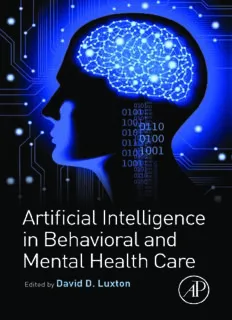
Artificial Intelligence in Behavioral and Mental Health Care PDF
Preview Artificial Intelligence in Behavioral and Mental Health Care
Artificial Intelligence in BEHAVIORAL AND MENTAL HEALTH CARE This pageintentionallyleftblank Artificial Intelligence in BEHAVIORAL AND MENTAL HEALTH CARE Edited by David D. Luxton PhD., M.S. Department of Psychiatryand BehavioralSciences, University of WashingtonSchool of Medicine,Seattle, WA, USA and Naval Health Research Center, SanDiego,CA, USA AMSTERDAM(cid:129)BOSTON(cid:129)HEIDELBERG(cid:129)LONDON NEWYORK(cid:129)OXFORD(cid:129)PARIS(cid:129)SANDIEGO SANFRANCISCO(cid:129)SINGAPORE(cid:129)SYDNEY(cid:129)TOKYO AcademicPressisanimprintofElsevier AcademicPressisanimprintofElsevier 125,LondonWall,EC2Y5AS 525BStreet,Suite1800,SanDiego,CA92101-4495,USA 225WymanStreet,Waltham,MA02451,USA TheBoulevard,LangfordLane,Kidlington,OxfordOX51GB,UK Copyrightr2016ElsevierInc.Allrightsreserved. Chapter8:Copyrightr2016LaurelRiek.Allrightsreserved.PublishedbyElsevierInc. Nopartofthispublicationmaybereproducedortransmittedinanyformorbyanymeans,electronicormechani- cal,includingphotocopying,recording,oranyinformationstorageandretrievalsystem,withoutpermissionin writingfromthepublisher.Detailsonhowtoseekpermission,furtherinformationaboutthePublisher’spermis- sionspoliciesandourarrangementswithorganizationssuchastheCopyrightClearanceCenterandtheCopyright LicensingAgency,canbefoundatourwebsite:www.elsevier.com/permissions. ThisbookandtheindividualcontributionscontainedinitareprotectedundercopyrightbythePublisher(other thanasmaybenotedherein). Notices Knowledgeandbestpracticeinthisfieldareconstantlychanging.Asnewresearchandexperiencebroadenour understanding,changesinresearchmethods,professionalpractices,ormedicaltreatmentmaybecomenecessary. Practitionersandresearchersmustalwaysrelyontheirownexperienceandknowledgeinevaluatingandusingany information,methods,compounds,orexperimentsdescribedherein.Inusingsuchinformationormethodsthey shouldbemindfuloftheirownsafetyandthesafetyofothers,includingpartiesforwhomtheyhaveaprofessional responsibility. Tothefullestextentofthelaw,neitherthePublishernortheauthors,contributors,oreditors,assumeanyliability foranyinjuryand/ordamagetopersonsorpropertyasamatterofproductsliability,negligenceorotherwise,or fromanyuseoroperationofanymethods,products,instructions, orideascontainedinthematerialherein. BritishLibraryCataloguing-in-PublicationData AcataloguerecordforthisbookisavailablefromtheBritishLibrary. LibraryofCongressCataloging-in-PublicationData AcatalogrecordforthisbookisavailablefromtheLibraryofCongress. ISBN:978-0-12-420248-1 ForInformationonallAcademicPresspublications visitourwebsiteathttp://store.elsevier.com/ Publisher:NikkiLevy AcquisitionEditor:NikkiLevy EditorialProjectManager:BarbaraMakinster ProductionProjectManager:NickyCarter Designer:MatthewLimbert TypesetbyMPSLimited,Chennai,India www.adi-mps.com PrintedandboundintheUSA CONTENTS ListofContributors ix AbouttheEditor xi Preface xiii 1. AnIntroductionto Artificial Intelligence inBehavioral andMentalHealth Care 1 DavidD.Luxton IntroductionandOverview 1 KeyConceptsandTechnologies 2 BenefitsofAIforBehavioralandMentalHealthCare 15 AdditionalConsiderations 17 Conclusion 19 References 21 AdditionalResources 25 2. Expert Systemsin Mental Health Care: AIApplications inDecision-Making andConsultation 27 CaseyC.BennettandThomasW.Doub Introduction 27 TheHistory(cid:1)ExpertSystemsandClinicalArtificialIntelligenceinHealthCare 28 ThePresent(cid:1)DynamicalApproachestoClinicalAIandExpertSystems 32 Technology-EnhancedClinicians 37 SummaryofDynamicalApproachesforClinicalAI 38 TheFuture 39 Conclusion 46 References 47 3. Autonomous VirtualHuman Agentsfor Healthcare Information Supportand Clinical Interviewing 53 AlbertRizzo,RussellShilling,EricForbell,StefanScherer, JonathanGratchandLouis-PhilippeMorency Introduction 53 TheRationaleandBriefHistoryoftheClinicalUseofVHs 55 UseCases:SimCoachandSimSensei 59 v vi Contents ComparativeEvaluationAcrossInterviews:Face-To-Face,WoZ, andAutomaticInteractionwiththeSimSenseiVHAgent 70 Conclusions 74 References 75 4. Virtual Affective Agentsand Therapeutic Games 81 EvaHudlicka Introduction 81 BriefHistoryofVirtualAffectiveAgentsandSeriousGames 84 StateoftheArt 88 ApplicableEthicalandPrivacyConsiderations 104 FutureProspects 107 Conclusions 111 References 111 5. Automated Mental State Detectionfor MentalHealth Care 117 SidneyK.D’Mello Introduction 117 TheoreticalandTechnicalFoundation 119 ExampleSystems 122 ConcludingRemarks 131 Acknowledgments 132 References 132 6. IntelligentMobile, Wearable,and AmbientTechnologies for Behavioral Health Care 137 DavidD.Luxton,JenniferD.June,AkaneSanoandTimothyBickmore Introduction 137 IntelligentCapabilitiesforMobileHealth 139 OverviewofAmI 150 DesignRecommendations 152 Conclusion 156 References 157 7. ArtificialIntelligence and Human Behavior Modeling and Simulationfor Mental Health Conditions 163 BarryG.Silverman,NancyHanrahan,LinaHuang,EmiliaFloresRabinowitz andSamuelLim Introduction 163 Contents vii Background 163 HistoryofABMSinMedicine/MentalHealthCare 166 SynergieswithOtherIndustries 167 SociologicalInputsintoMulti-TieredABMS 167 AToolboxforMulti-LayerModelingofSocialSystems 169 DataandPrivacyConstraintsforABMSinMentalHealthModeling Applications 175 ExampleApplication 177 FutureProspects 180 Conclusion 181 Acknowledgments 181 References 182 8. Robotics Technology in Mental Health Care 185 LaurelD.Riek Introduction 185 Conclusion 199 Acknowledgment 200 References 200 9. Public Health Surveillance: Predictive Analytics andBig Data 205 ChrisPoulin,PaulThompsonandCraigBryan Introduction 205 TheCurrentStateofInformatics 206 OverviewofRecentApplications 206 Results 215 LargerCohorts(CurrentWork) 218 Impact 220 ApplicableEthicalConsiderations 222 FutureProspectsintheTopicArea 224 Conclusion 228 References 228 10. Artificial Intelligence in Public Health Surveillance and Research 231 YairNeuman Introduction 231 Conclusion 251 References 252 viii Contents 11. EthicalIssues and Artificial Intelligence Technologies in Behavioral and Mental Health Care 255 DavidD.Luxton,SusanLeighAndersonandMichaelAnderson Introduction 255 OverviewofEthicsCodesandEthicalBehaviorinHealthCare 256 ParticularEthicsChallenges 261 DesignandTestingRecommendations 270 Conclusion 274 References 275 Glossary 277 Index 281 LIST OF CONTRIBUTORS MichaelAnderson DepartmentofComputerScience,UniversityofHartford,WestHartford,CT,USA SusanLeighAnderson DepartmentofPhilosophy,UniversityofConnecticut,Stamford,CT,USA CaseyC.Bennett SchoolofInformaticsandComputing,IndianaUniversity,Bloomington,IN,USA; DepartmentofInformatics,CenterstoneResearchInstitute,Nashville,TN,USA TimothyBickmore CollegeofComputerandInformationScience,NortheasternUniversity,Boston, MA,USA CraigBryan DepartmentofPsychology,TheUniversityofUtah,SaltLakeCity,UT,USA SidneyK.D’Mello DepartmentsofPsychologyandComputerScience,UniversityofNotreDame,Notre Dame,IN,USA ThomasW.Doub DepartmentofInformatics,CenterstoneResearchInstitute,Nashville,TN,USA EricForbell UniversityofSouthernCaliforniaInstituteforCreativeTechnologies,LosAngeles, CA,USA JonathanGratch UniversityofSouthernCaliforniaInstituteforCreativeTechnologies,LosAngeles, CA,USA NancyHanrahan SchoolofNursing,UniversityofPennsylvania,Philadelphia,PA,USA LinaHuang ElectricalandSystemsEngineering,UniversityofPennsylvania,Philadelphia,PA,USA EvaHudlicka PsychometrixAssociates,Inc.andSchoolofComputerScience,Universityof Massachusetts,Amherst,MA,USA JenniferD.June NationalCenterforTelehealth&Technology,WA,USA;DepartmentofHuman CenteredDesignandEngineering,UniversityofWashington,Seattle,WA,USA ix
Description: